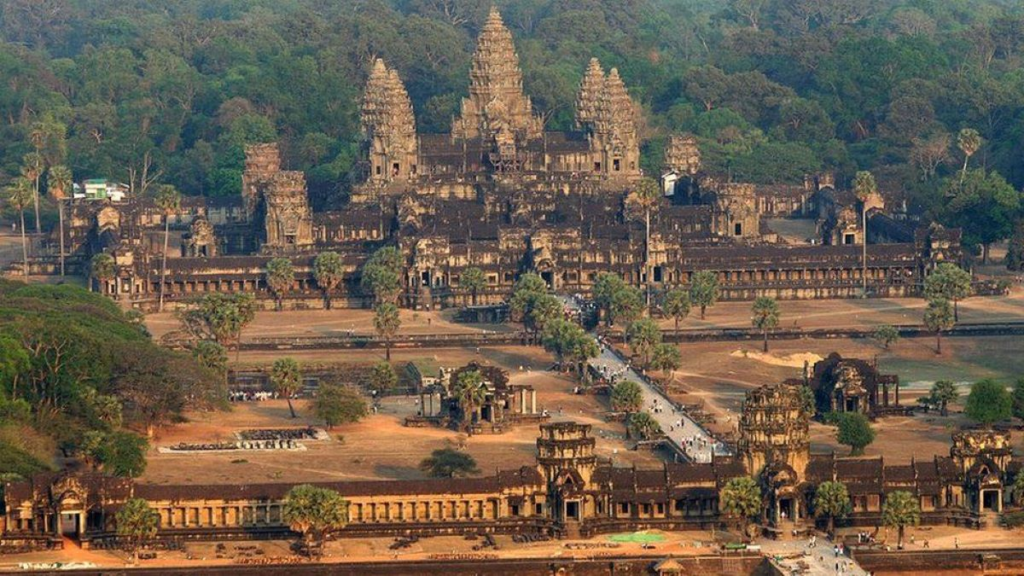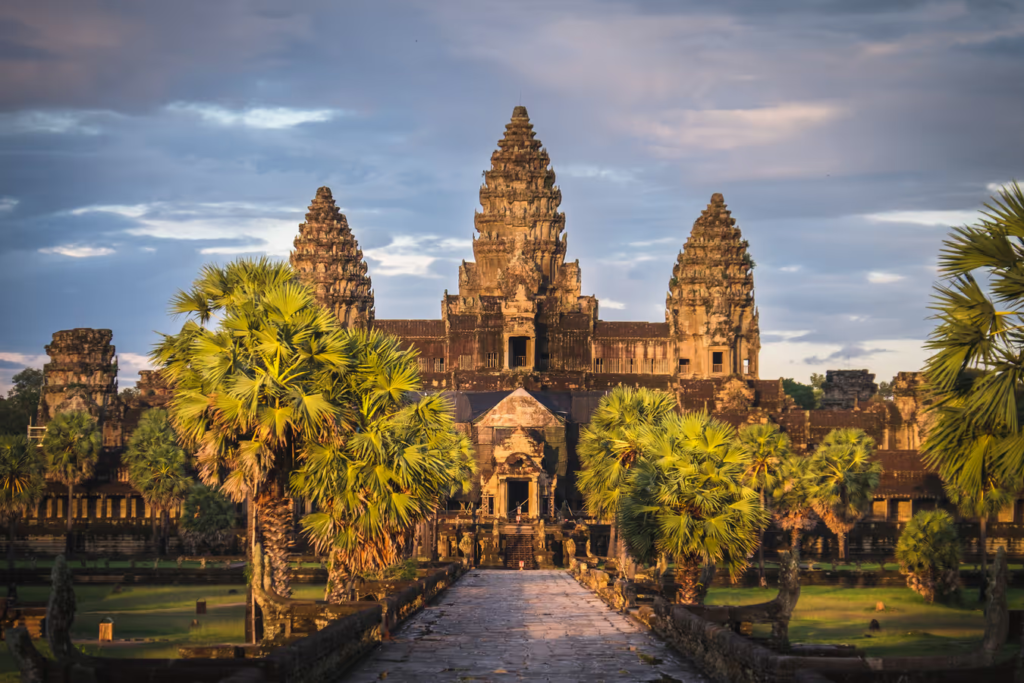Angkor Wat, a name that resonates with grandeur and historical magnificence, is not just a monument; it is a symbol of Cambodia’s rich cultural heritage and architectural brilliance. As the largest religious monument in the world, Angkor Wat is an awe-inspiring complex that showcases the zenith of Khmer architecture.
Located near the town of Siem Reap, Angkor Wat attracts millions of tourists annually, drawn to its remarkable beauty, intricate design, and the fascinating history it represents.
The Geography of Angkor Wat
Angkor Wat is situated in the northwestern region of Cambodia, approximately 5.5 kilometers north of Siem Reap. The temple complex lies within the vast Angkor Archaeological Park, which covers an area of over 400 square kilometers.
This park, a UNESCO World Heritage Site, contains the remains of several capitals of the Khmer Empire from the 9th to the 15th century. Surrounded by lush forests, rivers, and moats, the geography of Angkor Wat creates an enchanting atmosphere that further enhances the mystique of this ancient temple.
The region around Angkor Wat is characterized by tropical weather, with heavy monsoon rains that feed the reservoirs and moats surrounding the temple complex. The Tonle Sap Lake, located to the south of Angkor Wat, played a crucial role in the success of the Khmer Empire.
It provided water for agriculture, enabling the construction of such an immense monument, and its proximity to the temple highlights the Khmer people’s profound understanding of hydraulic engineering.
Historical Significance of Angkor Wat
Angkor Wat was initially built as a Hindu temple dedicated to the god Vishnu during the reign of King Suryavarman II in the early 12th century.
Read : Cambodia: The Land of Ancient Temples and Timeless Treasures
The name “Angkor Wat” means “City of Temples” in Khmer, reflecting its role as a central place of worship and pilgrimage. Unlike most other Angkorian temples, which were aligned toward the east, Angkor Wat was oriented to the west, a direction associated with Vishnu and death in Hindu cosmology.
Read : Divine Journeys: Ten Must-Visit Hindu Temples Around the Globe
As the Khmer Empire gradually embraced Buddhism in the late 13th century, Angkor Wat transitioned into a Buddhist temple, which it remains to this day.
The temple’s significance transcends religious boundaries, standing as a symbol of national pride for Cambodia. Angkor Wat is depicted on the Cambodian flag, and it serves as a source of inspiration for Cambodians, reflecting the country’s cultural and spiritual identity.
Architecture of Angkor Wat
The architectural design of Angkor Wat is a masterpiece of symmetry, proportion, and craftsmanship. The temple complex covers an area of 162.6 hectares, making it the largest religious structure in the world.
Its central tower rises to a height of 65 meters, surrounded by four smaller towers, symbolizing the five peaks of Mount Meru, the mythical center of the universe in Hindu and Buddhist cosmology.

The temple is surrounded by a vast moat, which not only provided protection from invaders but also represented the cosmic ocean surrounding Mount Meru. The causeway leading to the temple is lined with statues of Naga serpents, mythical creatures that were believed to act as protectors of the temple.
Inside the temple, visitors are greeted by intricately carved bas-reliefs that depict scenes from Hindu mythology, including the famous “Churning of the Ocean of Milk,” a legendary episode from the Mahabharata.
These carvings are among the finest examples of Khmer art, showcasing the skill and dedication of the artisans who worked on the temple. The galleries, courtyards, and chambers of Angkor Wat are laid out in a series of concentric squares, with the central sanctuary housing a statue of Vishnu.
The overall design of the temple reflects the Hindu concept of the universe, with the central tower representing the sacred Mount Meru and the surrounding walls and moat symbolizing the mountains and oceans of the world.
The Construction of Angkor Wat
The construction of Angkor Wat is a testament to the engineering prowess of the Khmer Empire. Built over three decades during the reign of King Suryavarman II, the temple required the labor of thousands of workers, including artisans, architects, and engineers. The sandstone used in its construction was quarried from the nearby Kulen Mountains and transported to the site using a network of canals and rivers.
One of the most remarkable features of Angkor Wat’s construction is its extensive use of corbelled arches, which allowed the builders to create large open spaces without the need for supporting beams. This technique was revolutionary for its time and contributed to the temple’s grandeur and durability.

In addition to its architectural innovations, Angkor Wat is also notable for its hydraulic engineering. The complex irrigation system, including moats, reservoirs, and canals, ensured a steady supply of water for agriculture and temple maintenance. This system played a crucial role in sustaining the temple and the surrounding population, particularly during periods of drought.
Religious and Cultural Symbolism
Angkor Wat’s religious and cultural symbolism is deeply rooted in both Hinduism and Buddhism. Initially built as a Hindu temple, it was dedicated to Vishnu, one of the principal deities of Hinduism.
The temple’s orientation toward the west, unusual for a Hindu temple, has led scholars to speculate that it may have been intended as a funerary temple for King Suryavarman II, with Vishnu serving as the god of death and rebirth.
The bas-reliefs and sculptures within Angkor Wat depict scenes from Hindu epics such as the Ramayana and Mahabharata, as well as cosmological themes like the “Churning of the Ocean of Milk.”
This mythological episode, which involves the gods and demons working together to obtain the elixir of immortality, is a central theme in Hindu art and symbolism. The carving of this scene at Angkor Wat is one of the most famous and intricate examples of Khmer art.

When the Khmer Empire gradually transitioned to Buddhism in the late 13th century, Angkor Wat was transformed into a Buddhist temple. Images of the Buddha were added to the temple’s galleries, and it became a site of pilgrimage for Buddhists across Southeast Asia. Today, Angkor Wat is considered a symbol of Cambodia’s spiritual heritage, representing both Hindu and Buddhist traditions.
Restoration and Preservation Efforts
Angkor Wat’s long history has not been without challenges. Over the centuries, the temple complex suffered from neglect, environmental degradation, and the effects of war.
During the 20th century, particularly under the Khmer Rouge regime, the temple faced significant damage. However, international efforts to restore and preserve Angkor Wat began in earnest in the 1990s.
The World Monuments Fund and UNESCO have played crucial roles in the preservation of Angkor Wat, conducting extensive restoration projects to stabilize the structure and protect it from further damage.
These efforts have included cleaning and repairing the bas-reliefs, reinforcing the foundations, and improving drainage systems to prevent water damage.
In addition to physical restoration, there have been efforts to manage the growing number of tourists visiting the temple each year. While tourism has brought economic benefits to Cambodia, it has also placed pressure on the fragile site.
To ensure the sustainability of Angkor Wat, authorities have implemented measures such as limiting the number of visitors allowed in certain areas and promoting responsible tourism practices.
Angkor Wat Today: A Tourist and Pilgrimage Destination
Today, Angkor Wat stands as one of the most iconic and visited tourist destinations in the world. Its status as a UNESCO World Heritage Site, combined with its historical, architectural, and spiritual significance, draws millions of visitors from around the globe.
The temple complex offers a unique glimpse into the grandeur of the Khmer Empire and its enduring cultural legacy. Tourists visiting Angkor Wat can explore its vast galleries, courtyards, and towers, marveling at the intricate carvings and awe-inspiring architecture.
The best time to visit is during sunrise or sunset when the temple is bathed in a golden light that enhances its beauty. The reflection of Angkor Wat in the surrounding moat during these times creates a breathtaking scene, making it a favorite among photographers.

For Buddhists, Angkor Wat remains a place of pilgrimage and worship. The temple’s spiritual significance is still felt today, with monks and devotees often seen praying or conducting ceremonies within its walls. Despite its popularity as a tourist destination, Angkor Wat continues to be a living temple, where religious practices are still observed.
The Cultural Legacy of Angkor Wat
Angkor Wat is more than just a historical monument; it is a symbol of Cambodia’s resilience and cultural identity. Throughout its long history, the temple has witnessed the rise and fall of empires, wars, and natural disasters, yet it remains a testament to the enduring spirit of the Khmer people.
The cultural legacy of Angkor Wat extends beyond its architectural and artistic achievements. It has inspired generations of Cambodians, serving as a symbol of national pride and unity.
The temple is featured on the Cambodian flag, and its image is used in countless cultural and political contexts, reflecting its importance to the nation’s identity. In addition to its national significance, Angkor Wat has also had a profound influence on the art and architecture of Southeast Asia.
Its design elements, such as the use of corbelled arches and intricate bas-reliefs, can be seen in temples and monuments across the region. Angkor Wat’s legacy is a reminder of the Khmer Empire’s cultural and intellectual contributions to the world.
The Timeless Wonder of Angkor Wat
Angkor Wat is a timeless wonder, a masterpiece of architecture, and a symbol of Cambodia’s rich cultural heritage. From its origins as a Hindu temple dedicated to Vishnu to its transformation into a Buddhist site of worship, Angkor Wat has stood the test of time, preserving the legacy of the Khmer Empire for future generations to admire.

As one of the most iconic and visited monuments in the world, Angkor Wat continues to inspire awe and wonder in all who visit. Its intricate design, historical significance, and spiritual symbolism make it a site of pilgrimage, tourism, and cultural pride. Angkor Wat is not just a relic of the past; it is a living testament to the enduring power of human creativity, spirituality, and resilience.

